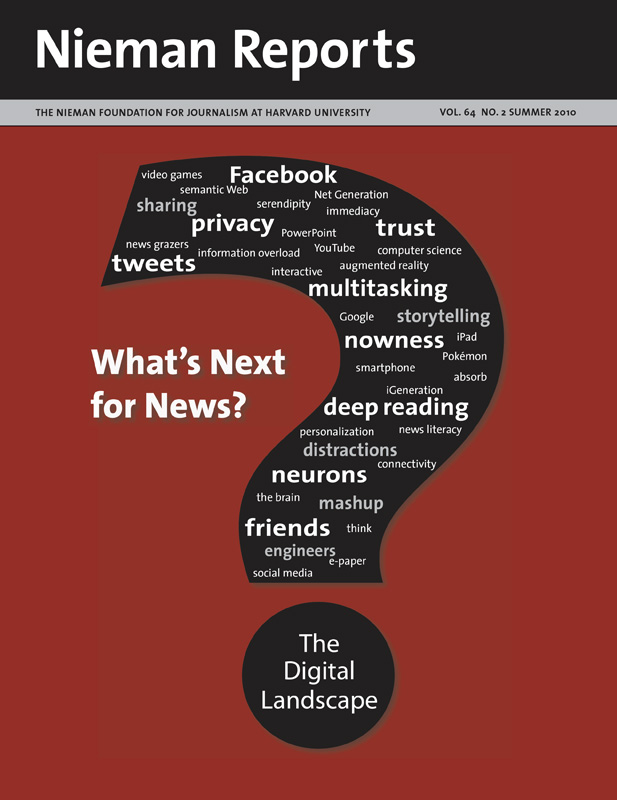In the early 1990’s, I became managing editor of Saint Paul, Minnesota’s Pioneer Press, a proud Knight Ridder newspaper locked in mortal daily combat with Minneapolis’s Star Tribune, just across the river. I recall well the day when I had to make my first tough calls—the news we were going to place prominently on Page One and the news we weren’t. I felt an odd mix of exhilaration and fear.
I was the final arbiter of what would greet several hundred thousand people who picked up the paper each morning. What if I chose wrong? So I focused on choosing right, and with that confidence grew the assumed power and nonchalant arrogance of the gatekeeper. That’s what top editors were, and still are, though their power is diminishing each day by weakening print circulation and an odd feeling of being on the losing side in history’s march into digital journalism.
In this hybrid era of straddling print and digital publishing, the role of the gatekeeper has markedly morphed. It’s shifted from “us” to “them,” but “them” includes a lowercase version of “us,” too. Gatekeeping is now a collective pursuit; we’ve become our own and each other’s editors. I picked this idea to be the lead trend in my book “Newsonomics: Twelve New Trends That Will Shape the News You Get,” published earlier this year by St. Martin’s Press. I called the chapter “In the Age of Darwinian Content, You Are Your Own Editor,” and since I named it I’ve never regretted giving it top billing.
Consider recent supporting evidence:
- The Pew Research Center’s Project for Excellence in Journalism and the center’s Internet & American Life Project reported that 75 percent of online news consumers in the United States get news forwarded through e-mail and posts on social sites. Fifty-two percent share links to news stories via social media.
- Research I conducted in July 2009 with Outsell, a research firm focused on the publishing industry, showed that of those Americans who use social sites, some 49 percent said they used Facebook for news. Twenty percent used Twitter.
- Those little bit.ly URLs, shortened for Twitter, are now driving more than two billion visits a month.
- My own anecdotal research talking to news companies shows that social sites are the fastest-growing source of traffic to news sites, “referrers,” in Web lingo. The Wall Street Journal says it’s getting about 7 percent of its traffic from social sites. The phenomenon, like digital media, is global: Mexico City’s El Universal tells me social sites drive more than 15 percent of traffic.
Social Trumps News
Twitter for news? Facebook for news? Just as we were getting used to saying “Google News”—remember how odd that sounded five years ago?—we find ourselves in the midst of a new revolution. Now we have to figure out—and act on—the socialization of news. With social media, the serendipity that came with turning pages and suddenly discovering a gem of a story that an editor put there happens in new ways. We’re re-creating such moments ourselves, each of us—individually and collectively—as we tout stories and posts to each other. A friend e-mails us a story; we might read it, time permitting. We get the same story from three people, and chances are good that we’ll carve out time to take a look.
It’s a different notion of serendipity, and for some people, it doesn’t equate, but it is what it is in this digital space. And here’s the difference: With social media the chances are good that like-minded friends—not to be confused with the strangers who were news editors—recommend a story because they believe you’ll be drawn to either its topic or argument.
We now see the early experiments to harness this new power. CNN, The Washington Post, and ABC News are turning the Facebook phenomenon to their advantage. Using Facebook’s extensions, these sites’ readers can see what stories their networks of friends like—and thereby recommend. It’s a new serendipity—and one that leverages the digital world as it works, not as some journalists wish it would.
We’re experiencing a loose democratization of gatekeeping—reinvented on the fly and in the ungainly ways typical of the digital revolution—and therefore we should expect such innovations to have legs. In December 2009, Nielsen Company reported that the average American spent six hours and nine minutes on social sites, up 143 percent in just a year.
It’s About Me
Is this about Facebook? No, I think it’s about something near and dear to all of us: me. Some might recall that back in the ’90s news sites actively promoted “make us your homepage” buttons in the (misguided, it seems) belief that online news sites would be a center of digital readers’ lives, as the daily newspaper had long been. Instead, as things turned out, digital places like Facebook organize our lives around, well, us.
Stated simply: I am the new homepage. Stuff gets to our pages in all kinds of ways, including the semi-serendipitous sharing. All of this, while interesting, might be just prologue. News aggregation is young on Twitter or Facebook, and even on the old folks, Google and Yahoo!. Very first-generation, very primitive, and done by amateurs for amateurs, largely.
So a looming question is who will emerge to lead the younger generations in bringing content together? Creating hybrid products? Weaving news onto social platforms? Socializing on a news platform? Other yet-to-be envisioned iterations?
Journalists ought to be among those who embrace these challenges—make them part of what they think about and do every day, and have their experimentation go beyond their own participation as individuals in this social sphere. We’ll learn by trying new ways of doing what we’ve done with news, by putting ourselves visibly in the social media mix, and by using the emerging tools of daily communication in all aspects of our work. It’s not enough to watch from the sidelines or even to try to mimic what kids do.
News in Social Media
The social dynamics of news will undoubtedly lead us into uncharted waters. And there will be business implications yet unimagined, some that look less rosy for our profession than others. So we are faced with how we can best prepare for inevitable adjustments as we think about how activities related to news reporting and storytelling can benefit and how we can strategize wisely about ways to deliver the news.
From the perspective of business, it’s likely we will soon see the news industry percolate with ideas about social media optimization, just as search engine optimization grew greatly as a business proposition during the last decade. Issues to think about: How do we write headlines with the dynamics of social media in mind? What’s the best way to encourage retweets? How do we utilize the “liking” strategies that showed up recently on Facebook?
In some news organizations, editors are leading the way as they encourage—in some cases, even mandate—that reporters and writers promote their stories (and themselves) routinely through social media. And this makes sense; experimentation and testing is now happening so it’s important for journalists to carry their principles into this social media environment, even as they keep a watchful eye out for useful practices.
The challenge for editors goes beyond their participation and exhorting their charges to do the same. Return, for a moment, to consider the editor’s customary role as gatekeeper—and think about the most valued attribute of the job. It went by various names and phrases—judgment, news sense, news judgment—but at its core, the job was about these things (and more): What makes a good story? When and how to push a reporter to take a story deeper? When to publish it? When to wait? Where to place it?
Today, things work differently. The attitude—as well as the mechanics—for attracting readers has to change. It’s no longer “take my judgment on the day’s news or good luck finding another local daily.” And even though readers are no longer captive to what an editor decides, people still want some help when it comes to deciding how and where to look for the news they value.
Go ahead and call it gatekeeping, but think of it with a different slant when it comes to flexing those well-honed news judgment muscles. These days editors have a much bigger bank of news and features on which to draw. It’s not just what staff reporters and wire copy offers; it’s the entire Web of content. Some editors connect—and collaborate—with local bloggers and hyperlocal Web sites. Others go in search of health or travel or financial news to fill holes in—or supplement—their coverage. These largely exist as modules of other people’s content floating in a sea of the news site’s own content.
The natural and next step would be smart aggregation. This means figuring out how to guide visitors to the best content—so here’s another place where judgment comes in. It can be organized—with social media sensibilities in mind—by locality or topic, by its social currency or its perceived value as news. Offer packages of content, some produced by your news organization, some by others. Help visitors find them, then make it easy, as many sites already do, to share what they find on Facebook or whatever popular social media site comes along.
It comes down to this: Use old muscles, but flex them in new ways. Tweet, yes, and post on Facebook walls, but perhaps with different messages tailored to each social venue. Keep those old world skills in mind—and yes, hold onto your news judgment, while adapting to the digital demands of readers.
Ken Doctor is the author of “Newsonomics: Twelve New Trends That Will Shape the News You Get,” published by St. Martin’s Press, and a news industry analyst for Outsell, a global research and advisory firm. On his Web site, Newsonomics.com, he tracks the transformation of the news media, focusing on changing business models and the journalism created.




